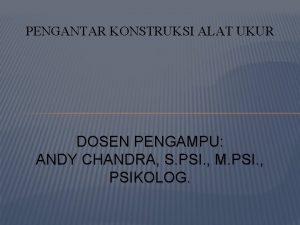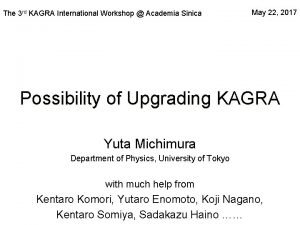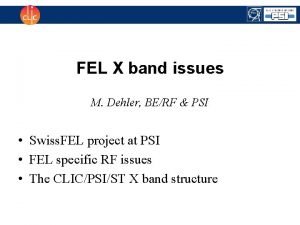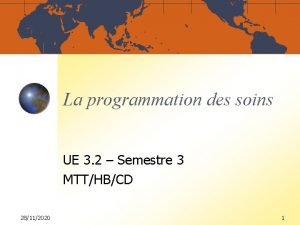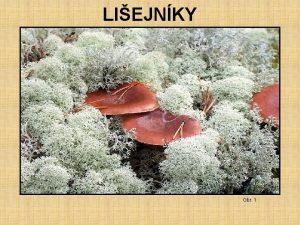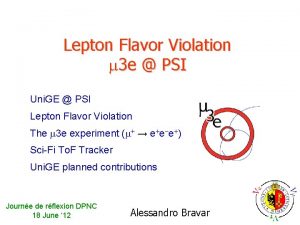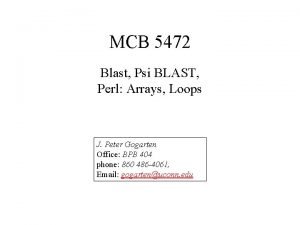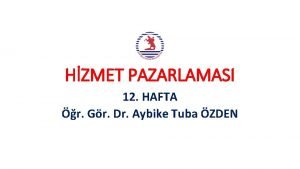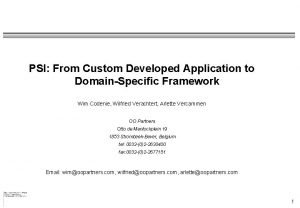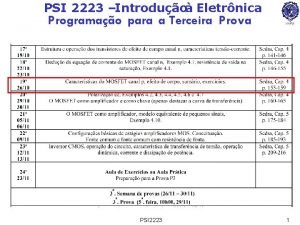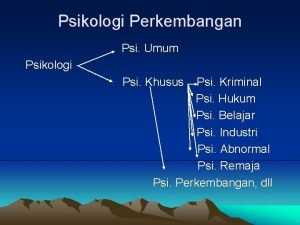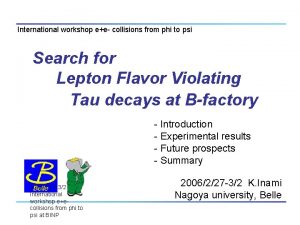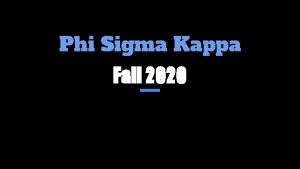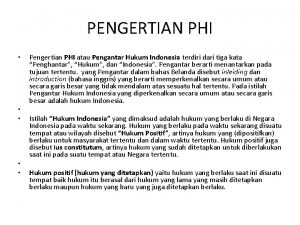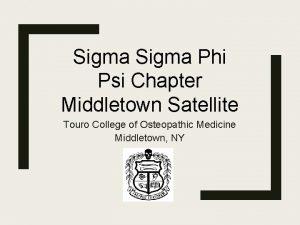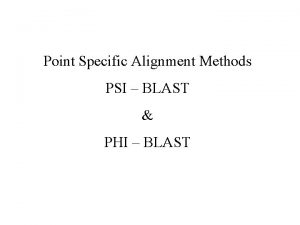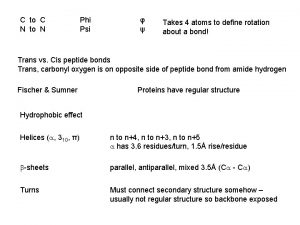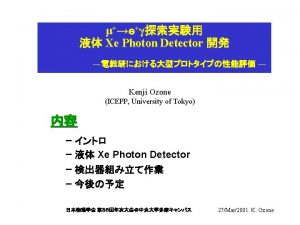International Workshop on ee from Phi to Psi

































- Slides: 33

International Workshop on e+e− from Phi to Psi , 13 -16 October, Beijing, China + – ee to charm cross sections via ISR Galina Pakhlova ITEP, Belle collaboration

Motivation to study cross sections e+e– → open charm Parameters of the JPC = 1– – conventional charmonia ψ(3770), ψ(4040), ψ(4160), ψ(4415) M, Γtot, Γee remain quite uncertain and model dependent To fix the resonance parameters we need to know their decay channels to take into account their interference: • non-resonant contribution • many open charm thresholds Phi to Psi 2009 Galina Pakhlova

BES fit to the inclusive R spectrum Phys. Lett. B 660, 315(2008) All possible two-body decays of ψ(3770), ψ(4040), ψ(4160), ψ(4415) are included Rres=RBW+Rint Resonance shapes ψ(3770) ψ(4040) ψ(4160) ψ(4415) Interference term M, Me. V Γtot , Me. V Γee , ke. V 3772. 92 ± 0. 35 27. 3 ± 1. 0 0. 265 ± 0. 018 3772. 0 ± 1. 9 30. 4 ± 8. 5 0. 22 ± 0. 05 4039 ± 1 80 ± 10 0. 86 ± 0. 07 4039. 6 ± 4. 3 84. 5 ± 12. 3 0. 83 ± 0. 20 4153 ± 3 103 ± 8 0. 83 ± 0. 07 4191. 7 ± 6. 5 71. 8 ± 12. 3 0. 48 ± 0. 22 4421 ± 4 62 ± 20 0. 58 ± 0. 07 4415. 1 ± 7. 9 71. 5 ± 19. 0 0. 35 ± 0. 12 Phi to Psi 2009 Significant effect of interference : model dependent! δ, deg PDG 09 0 BES 08 PDG 09 130 ± 46 BES 08 PDG 09 293 ± 57 BES 08 PDG 09 234 ± 88 Galina Pakhlova BES 08 To reduce model dependence we need to measure exclusive cross sections to open charm final states

Width, Ge. V ? Potential models & ψ states Mass spectrum • In general agreement with data Open charm decays • via nonperturbative gluodynamics ? • difficult to compute • good probes of strong QCD Only inclusive measurements ? More theoretical and experimental efforts are required E. Swanson, Phys. Reports 429(2006) Phi to Psi 2009 Galina Pakhlova

Charmoniumlike 1– – family One more reason to study e+e– to charm cross sections The nature of the charmoniumlike 1– – family with masses above open charm threshold remains unclear • Their properties are inconsistent with conventional charmonium Phi to Psi 2009 Galina Pakhlova

ar. Xiv: 0808. 1543 Y(4260) NEW 344± 39 ev Y(4008) 454 fb-1 Br(J/ψπ+π–)Γee , e. V Solution 1 Y(4008) Solution 2 < 0. 7 90% CL Solution 1 Y(4260) Solution 2 7. 5± 0. 9± 0. 8 Absence of open charm production is inconsistent with conventional charmonium Phi to Psi 2009 Galina Pakhlova e+e–→J/ψπ+π– γISR Y(4260). . . Y(4008)?

PRD 78, 014032 (2008) (2007) PRL 98, 212001 Y(4360)→ψ(2 S)ππ Y(4360) Y(4660)? Y(4660) 6. 1σ Combined fit to Ba. Bar&Belle e+e–→ψ(2 S) π+π– γISR +π – γ data Y(4360), on e+e–→ (2 S) π Y(4660). . . ISR Best measurements of Y(4360) and Y(4660) 298 fb-1 PRL 99, 142002 (2007) 2 -BW fit with interference Assume all the cross sections are due to Y(4660) Y(4360) and Y(4660) added coherently 5. 8σ 8σ Br(ψ(2 S)π+π–)Γee , e. V Solution 1 Solution 2 Absence of open charm production is inconsistent with conventional charmonium 670 fb-1 Y(4360) Y(4660) Phi to Psi 2009 Galina Pakhlova

Y states vs inclusive cross section e+e–→hadrons if Ruds=2. 285± 0. 03 Y(4660) ψ(4415) y Y(4260) Y(4325) Y(4360) y (4160) ψ(4040) y Y(4008) ψ(3770) y R(s) = σ(e+e–→hadrons)/σ(e+e–→μ+μ–) – Ruds Durham Data Base Peak positions for M(J/ ) & M( (2 S) ) significantly different Y(4260) mass corresponds to dip in inclusive cross section Phi to Psi 2009 Galina Pakhlova

Potential models & Y states No room for Y states among conventional 1– – charmonium S. Godfrey and N. Isgur PRD 32, 189 (1985) 4660 33 S 1 = (4040) 23 D 1 = (4160) 43 S 1 = (4415) 4350 4260 4008 masses of predicted 33 D 1 (4520) 53 S 1 (4760) 43 D 1(4810) are higher (lower) Phi to Psi 2009 Galina Pakhlova

Interpretations of Y states Y(4360) &Y(4660) are conventional charmonia with shifted masses • Y(4360) = 33 D 1 , Y(4660) = 53 S 1 G. J Ding, J. J. Zhu, M. L. Yan, Phys. Rev. D 77: 014033 (2008) A. M. Badalyan, B. L. G. Bakker, I. V. Danilkin, Phys. Atom. Nucl. 72: 638 -646, (2009) • 43 S 1 ≠ ψ(4415) = 43 D 1(4661); Y(4360)=43 S 1(4389) , Y(4660)=53 S 1 (4614) or 43 D 1(4661) J. Segovia, A. M. Yasser, D. R. Entem, F. Fernandez Phys. Rev. D 78: 114033, (2008). Charmonium hybrids Zhu S. L. ; Close F. E. ; Kou E. and Pene O. • The lightest hybrid is expected by LQCD around 4. 2 Ge. V • The dominant decays Y(4260)→D(*)π, via virtual D** Hadro-charmonium • Specific charmonium state “coated” by excited light-hadron matter S. Dubinskiy, M. B. Voloshin, A. Gorsky Multiquark states • [cq] tetraquark • DD 1 or D*D 0 molecules Maiani L. , Riquer V. , Piccinini F. , Polosa A. D. Swanson E. ; Rosner J. L. , Close F. E. Heavy meson hadronic molecules • Y(4660) is (2 S)f 0(980) bound state S-wave charm meson thresholds Phi to Psi 2009 F. K. Gou, C. Hanhart, S. Krewald, U. G. Meissner Lui X. Galina Pakhlova

Use ISR to measure open charm exclusive final states e + e- cc e+ s=(Ecm-E )2 -p 2 ISR at B factories Quantum numbers of final states are fixed JPC = 1– – Continuous ISR spectrum: • access to the whole √s interval em suppression compensated by huge luminosity • comparable sensitivity to energy scan (CLEOc, BES) Phi to Psi 2009 Galina Pakhlova

e+e– →DD via ISR with full reconstruction e+ e+ s=E 2 cm-2 EγEcm Full reconstruction of hadronic part ISR photon detection is not required • but used if it is in the detector acceptance Translate measured DD mass spectrum to cross section Phi to Psi 2009 Galina Pakhlova γ D D reconstructed e– ucted r t s n o c not re ectable et if und

σ(e+e− →DD) Phys. Rev. D 77, 011103(2008) Phys. Rev. D 76, 111105(2007) Phys. Rev. D 80, 072001(2009) • Broad structure around 3. 9 Ge. V • in qualitative agreement with coupledchannel model? Phi to Psi 2009 • Some structure at 4. 0 -4. 2 Ge. V • Statistics are small …ψ(4040)? ψ(4160)? • Hint of ψ(4415) Galina Pakhlova

e+e– →D(*)D* via ISR with partial reconstruction d s=E 2 cm-2 E Ecm D* no bu t rec t c on on str uc ain ted ed DD* & D*D* cte D(*) tru e– ons e+ rec e+ π D D* partial reconstruction • increase eff ~ 10 -20 times Detection of ISR photon Translate measured mass recoil against γISR ≡ D(*)D* mass spectrum to cross section Phi to Psi 2009 Galina Pakhlova

Exclusive e+e–→D(*)D* cross-sections Phys. Rev. Lett. 98, 092001 (2007) ψ(44 15) Phys. Rev. D 80, 072001(2009) D*+D*ψ(4040) ) 040 ψ(4160) ) 60 ψ(41 D+D*Y(4 260) 550 fb− 1 ψ(4160) ψ(4040) Systematic errors ≈ statistical errors D*D* • complicated shape of cross section • clear dip at M(D*D*) ~ 4260 Ge. V (similar to inclusive R) DD* • broad peak at threshold (shifted relative to 4040 Ge. V) Phi to Psi 2009 Galina Pakhlova

Ba. Bar: e+e−→ D(*)D* Phys. Rev. D 79, 092001(2009) DD DD* Full reconstruction of hadronic part • Both charged and neutral final states • Fit by sum of ψ states with fixed masses&widths from PDG (due to limited statistics) • No evidence is found for Y(4260)→ DD, DD*, D*D* D* D* 384 fb-1 Br ratios seem to disagree with potential models … … uncertainties are too large Phi to Psi 2009 Galina Pakhlova

Belle vs Ba. Bar: σ(e+e−→D(*)D*) Phys. Rev. Lett. 98, 092001 (2007) Phys. Rev. D 79, 092001(2009) Sum of two body open charm final states Belle & Ba. Bar results are in very good agreement Phi to Psi 2009 Galina Pakhlova

Three-body final states e+ d tructe s n o c not re tectable e if und e+ s=E 2 cm-2 E Ecm D* D π reconstructed e– D 0 D(*)− π+ Full reconstruction of hadronic part ISR photon detection is not required • but used if it is in the detector acceptance Translate measured DD(*)π mass spectrum to cross section Phi to Psi 2009 Galina Pakhlova

Resonant structure in (4415) D 0 D– + M(D 0π+) vs M(D–π+) from ψ(4415) region § Clear D*2(2460) signals § No non-D*2(2460) contribution Phys. Rev. Lett. 100, 062001(2008) M = 4411 ± 7 Me. V Γtot = 77 ± 20 Me. V Nev= 109 ± 25 670 fb-1 DD*2(2460) ~10σ DDπ non DD*2(2460) Consistent with BES, Phys. Lett. B 660, 315(2008) PDG 06, Barnes at. al Phys. Rev. D 72, 054026 (2005) σ(e+e–→ψ(4415))×Br(ψ(4415)→DD*2(2460))×Br(D*2(2460) →Dπ) = (0. 74 ± 0. 17 ± 0. 07)nb Br( (4415) D(D )non D 2(2460))/Br( (4415) DD*2(2460))<0. 22 Phi to Psi 2009 Galina Pakhlova

The first charm baryons final state = (50± 16)% s=E 2 cm -2 E Ecm no tr – ? p Λc– ec on str X uc t ed • combinatorial background suppressed by ≈ 10 Detect the high energy ISR photon Translate measured mass recoil against γISR ≡ Λc+ Λc mass spectrum to cross section Phi to Psi 2009 Galina Pakhlova d Br(Λc+→p. X) Λc+ cte Reconstruct Λc Use antiproton tag from inclusive Λc– →p– X + e+ tru e– ons e+ rec Partial reconstruction with anti-proton tag

partial reconstruction with ─ p tag Λ c no Σ– Λc (2765) Λc (2880) Λc (2625) Λc (2595) e+e–→Λc+Λc– γISR Clear peak in Mrec(Λc+γISR ) distribution at Λc mass. At mass > 2. 5 Ge. V/c 2 contributions from Λc+Λc–π0 • could proceed via Λc+Σ– ; violates s d n a ideb Λc s Mrecoil(Λc +γ and Λc+Λc–π π • could proceed via Λc+Λc(2595)–, Λc+Λc(2625)–, Λc+Λc(2765)–, Λc+Λc(2880)– Phys. Rev. Lett. 101, 172001(2008) ISR) Total refection contributions < 5% (included in systematics) Look at Mrecoil(γISR) ≡ Mass spectra of Λc+Λc– Phi to Psi 2009 isospin and should be strongly suppressed Galina Pakhlova e+e–→Λc+Λc– γISR X(4630) 8. 2σ 670 fb-1

Phys. Rev. Lett. 101, 172001(2008) Interpretations for X(4630) e+e–→Λc+Λc– γISR • no peak-like structure • X(4630) ≡ Y(4660)? JPC=1 • dibaryon threshold effect? • like in • X(4630) = Y(4660) = charmonium state 53 S 1 or 43 D 1 J. Segovia, A. M. Yasser, D. R. Entem, F. Fernandez • Charmonium state 63 S 1 B. Q. Li and K. T. Chao • Threshold effect E. Beveren, G. Rupp • Y(4660) = (2 S)f 0(980) bound state F. K. Gou, C. Hanhart, S. Krewald, U. G. Meissner • Point-like baryons R. B. Baldini, S. Pacetti, A. Zallo • X(4630) = Y(4660) D. V. Bugg Phi to Psi= 2009 • X(4630) Y(4660) = tetraquark D. Ebert, R. N. Fausov, V. O. Galkin Galina Pakhlova B→pΛπ, J/ψ→γpp

Searching for hybrids via their favorite decay modes Phi to Psi 2009 Galina Pakhlova

e+e− D 0 D*– + at s ~ 4− 5 Ge. V via ISR Full reconstruction No extra tracks Detection of γISR is not required • if γISR is detected • M(D 0 D*– +γISR) is required ~ Ecm γISR is not detected γISR is detected ar. Xiv: 0908. 0231 670 fb-1 Consistent with ISR production Combinatorial bgs are estimated from sidebands D and D* Other bgs are small and taken into account Small efficiency at threshould Phi to Psi 2009 Galina Pakhlova

in e+e– → D 0 D*– + γisr DD π & DD &D D * * D 1(2420)0 → D*– + ← D 2(2460)0 1 2 0 *– + 0 0 D D ↔ D D 1(2420) & D D 2(2460) e+e– → (4415)→D 0 D 2(2460)0→D 0 D– + is measured Main problem is to separate D 0 D 1(2420)0 from D 0 D 2(2460)0 • D 1(2420)0 : Γtot = 20. 4 ± 1. 7 Me. V • D 2(2460)0 : Γtot = 43 ± 4 Me. V (PDG 08) Phi to Psi 2009 D*– + Galina Pakhlova 2420 D 0 + 2460 Both DD 1 & D*D 2 are seen. . . but the statistics is not enough to study their mass spectra!

Exclusive e+e− D 0 D*– + cross-section ar. Xiv: 0908. 0231 Y(4260) Upper Limit ψ(4415) No evident structures: only UL’s ! Baseline fit: • RBW for (4415) & threshold function for non-resonant contribution without interference between amplitudes To obtain limits on X D 0 D*– +, X=Y(4260), Y(4360), Y(4660), X(4630) perform four fits each with one of the X states, (4415) and non-resonant contribution Interference could increase these UL’s by factors of 2− 4 depending on the final state Fix masses and total widths from PDG (for destructive solutions) σ(e+e–→ψ(4415))×Br(ψ(4415)→D 0 D*–π+)< 0. 76 nb at 90% CL Br(ψ(4415)→ D 0 D*–π+) < 10. 6 % at 90% CL UL at 90% CL Phi to Psi 2009 Galina Pakhlova

DDπ D*D* Λ c+Λ c– DD * π DD DD* Contribution to the inclusive cross section Phi to Psi 2009 Galina Pakhlova

Y(4260) Y(4360) ψ(4040) ψ(4160) Y(4008) D* D* Y states vs exclusive cross sections PRL 98, 092001 (2007) DD* PRD 77, 011103(2008) DD ψ(4415) ? PRL 100, 062001(2008) σ(e+e–→open charm) via ISR DDπ Y(4008) mass coincides with DD* peak Y(4260) mass corresponds to dip in D*D* cross section Around Y(4360) mass all measured cross sections are smooth Y(4660) mass is close to Λc+Λc– peak Signigicant “peak-like” enhancement near 3. 9 Ge. V in ee→DD coupled channel effect? or something else? ! PRL 101, 172001(2008) Λc+Λc– Y(4660) ar. Xiv: 0908. 0231 DD*π Phi to Psi 2009 s ago r a e y 30 Galina Pakhlova E. Eichten, et al Phys. Rev. D 21: 203, (1980)

DD DDπ DD* D*D* Sum of all exclusive contributions DD*π Λ +c Λ c Phi to Psi 2009 Only small room for unaccounted contributions • Charm strange final states Limited inclusive data above 4. 5 Ge. V • Charm baryons final states Galina Pakhlova

Cornell Coupled Channel model: R in the threshold region ar. Xiv: 0801. 3418 E. Eichten QWG 08 Complicated thresholds behaviour Need improved model to describe standard and to search for new states Phi to Psi 2009 Galina Pakhlova

In conclusion Phi to Psi 2009 Galina Pakhlova

Experiment For theory As Six exclusive open charm final states are measured DD, D*D*, DDπ, DD*π, ΛcΛc and Their sum is close to e+e– → hadrons & Cleo section measurements are nicely c cross. . . it’s Belle time&to. Bar describe these data by realistic common fit consistent with each other and to extract realistic parameters of states. . . In charm meson final states no evident peaks corresponding to members of charmoniumlike 1– – family are found !of Theoretical efforts to describe charm components inclusive cross section are kindly requested! Λ cΛ c All enhancement at threshold, quantum numbers, mass and width are presented sections can be found in Durham Data Base consistentcross with Y(4660) • Various interpretations • Phi to Psi 2009 Galina Pakhlova

Thank you! Phi to Psi 2009 Galina Pakhlova
 Gamma pi omega psi phi
Gamma pi omega psi phi Andy chandra s.psi m.psi
Andy chandra s.psi m.psi Phi e psi
Phi e psi Kagra international workshop
Kagra international workshop Psi
Psi Southwestern province kappa alpha psi
Southwestern province kappa alpha psi Mop maximum operating pressure
Mop maximum operating pressure Alpha kappa psi anthem
Alpha kappa psi anthem Psi concepts
Psi concepts Psi projet de soins informatisé
Psi projet de soins informatisé Hávnatka psí stélka
Hávnatka psí stélka Kortex psi
Kortex psi Norma psi
Norma psi Pazarlamanın 7 psi
Pazarlamanın 7 psi Kappa alpha psi k
Kappa alpha psi k Central tire inflator systems retrofit
Central tire inflator systems retrofit Zeta phi beta boule 2022 philadelphia dates
Zeta phi beta boule 2022 philadelphia dates Ucf online psychology
Ucf online psychology Fc in concrete
Fc in concrete Evap service port 1 psi maximum regulated pressure only
Evap service port 1 psi maximum regulated pressure only Kappa alpha psi southwestern province
Kappa alpha psi southwestern province Kappa alpha psi southwestern province
Kappa alpha psi southwestern province Primjer algoritma iz svakodnevnog života
Primjer algoritma iz svakodnevnog života Beta alpha psi fordham
Beta alpha psi fordham Kappa psi provinces
Kappa psi provinces Psi uni
Psi uni Psi-blast
Psi-blast Psi
Psi Aybike tuba özden
Aybike tuba özden Kappa alpha psi southwestern province
Kappa alpha psi southwestern province Personnel security definition
Personnel security definition Kryštofovy lyže stály opřené o skříň
Kryštofovy lyže stály opřené o skříň Psi framework
Psi framework Saturação
Saturação

